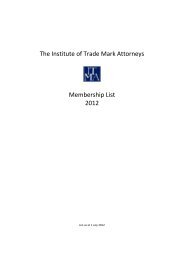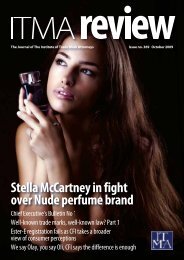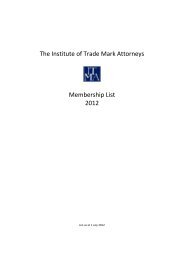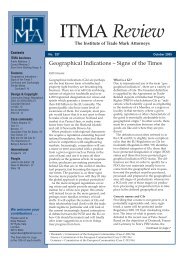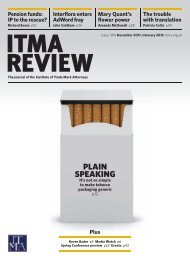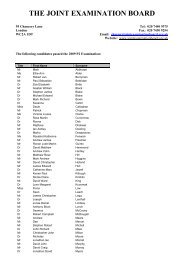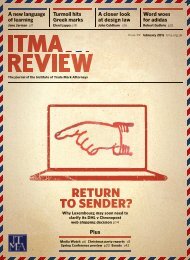case comment - ITMA
case comment - ITMA
case comment - ITMA
You also want an ePaper? Increase the reach of your titles
YUMPU automatically turns print PDFs into web optimized ePapers that Google loves.
CASE COMMENT<br />
Jennifer Sunderland<br />
The Court of Appeal has handed<br />
down its long-awaited decision in<br />
L’Oreal v Bellure. The decision<br />
implements the responses given by<br />
the ECJ (as it then was) in June 2009<br />
to questions referred to it by the<br />
Court of Appeal. Notably, it also<br />
includes an extensive explanation by<br />
Lord Justice Jacob of the reasons why<br />
he disagrees with the ECJ’s approach,<br />
although he recognises that the<br />
Court of Appeal is bound by it.<br />
This is a long-running dispute<br />
concerning fragrances intended to be<br />
“smell-alikes” for some of L’Oreal’s<br />
most famous perfumes. The<br />
defendants – Bellure, Malaika and<br />
Starion – had been using comparison<br />
lists which matched their copy<br />
perfumes to some of L’Oreal’s wellknown<br />
perfumes, using the L’Oreal<br />
registered marks. L’Oreal contended<br />
that this was an infringement under<br />
Article 5(1)(a) of the Trade Marks<br />
Directive (89/104). Historically there<br />
were also issues relating to the design<br />
of the defendants’ packaging, which<br />
the defendants had conceded.<br />
The Court of Appeal’s questions<br />
to the ECJ related to whether<br />
the defendants’ use of look-alike<br />
packaging had taken unfair<br />
advantage of the reputation of the<br />
relevant L’Oreal marks even though<br />
it did not “jeopardise the essential<br />
function of the registered trade mark<br />
as a guarantee of origin”. They also<br />
concerned the use of comparison<br />
lists.<br />
Further background may be<br />
found in an article on the ECJ’s<br />
decision by Cerryg Jones of<br />
CASE COMMENT<br />
Court of Appeal applies<br />
ECJ’s guidance reluctantly<br />
L'Oréal SA, Lancome Parfums et Beaute & CIE, Laboratoire Garnier<br />
& CIE –and- Bellure NV, Malaika Investments Ltd (t/a Honeypot<br />
Cosmetic & Perfumery Sales), Starion International Ltd, Court of<br />
Appeal [2010] EWCA Civ 535, Lord Justice Jacob, Lord Justice Wall<br />
and Lord Justice Rimer, 21 May 2010, Original Language: English.<br />
Jennifer Sunderland reports...<br />
Wragge & Co, available at<br />
www.wragge.com/analysis_4657.asp.<br />
Outcome<br />
Jacob LJ provided the leading<br />
judgment; Rimer LJ and Wall LJ<br />
concurred. He noted that it is lawful to<br />
make and sell a smell-alike product,<br />
that there was no customer confusion<br />
between L’Oreal’s perfumes and the<br />
cheap copies and that there was no<br />
tarnishment or blurring to the image<br />
or the distinctiveness of L’Oreal’s<br />
trade marks. Nor was there any effect<br />
on sales of the corresponding fine<br />
fragrances, since consumers who buy<br />
a “smell-alike” do so knowingly and<br />
would not purchase the genuine<br />
product. Nevertheless the evidence<br />
showed that the defendants achieved<br />
a promotional advantage by<br />
informing consumers which luxury<br />
perfumes the copy perfumes<br />
imitated, by reference to the<br />
claimant’s trade marks.<br />
Policy decision<br />
Jacob LJ’s view is that the ECJ has<br />
gone a step too far. He says that<br />
traders should not be prevented from<br />
making honest statements about<br />
lawful products, or competition will<br />
be impaired. In his view the ECJ’s<br />
approach is unnecessary and<br />
amounts to muzzling free speech; it<br />
also deprives consumers of choice. In<br />
his view the ECJ’s approach imposes<br />
a more restrictive and protective<br />
approach than in many other<br />
jurisdictions. These are substantive<br />
and very serious <strong>comment</strong>s, aimed in<br />
part at the Commission’s forthcoming<br />
review of EU trade mark law and<br />
referencing also the Commission’s<br />
submissions in a current reference to<br />
the Court of Justice of the European<br />
Union (the ECJ as was) in a current<br />
“Adwords” <strong>case</strong> (Interflora Inc v Marks<br />
and Spencer Plc [2010] EWHC 925<br />
(Ch)).<br />
Article 5(1)(a)<br />
The ECJ concluded that use of the<br />
trade marks to refer to L’Oreal’s<br />
product was not an infringement<br />
under Article 5(1)(a). However it<br />
held that use of the marks in the<br />
comparison lists also included use<br />
with reference to the copy perfumes<br />
for the purpose of advertising<br />
them, and such use did amount to<br />
infringement under Article 5(1)(a).<br />
The defendants had argued that<br />
such use is merely descriptive (as, for<br />
instance, in the <strong>case</strong> C-200 Hölterhoff<br />
[2002] EC I-4187). However the ECJ<br />
found that whilst the defendants’<br />
use of the marks did not affect their<br />
essential function it nevertheless<br />
affected other functions. Such<br />
functions include the guarantee<br />
of quality, and the advertising,<br />
communication and investment<br />
functions. Jacob LJ has <strong>comment</strong>ed<br />
that these functions are ill-defined<br />
and vague, and this is an aspect of the<br />
<strong>case</strong> which he wishes to draw to the<br />
attention of the Commission. In his<br />
view Article 5(1)(a) infringement<br />
should be confined to the essential<br />
function of distinguishing origin.<br />
What is not clear from the ECJ’s<br />
reasoning is whether Article 5(1)(a)<br />
can, like Article 5(2) in respect<br />
of unfair advantage, cover<br />
22 <strong>ITMA</strong> Review July/August 2010





